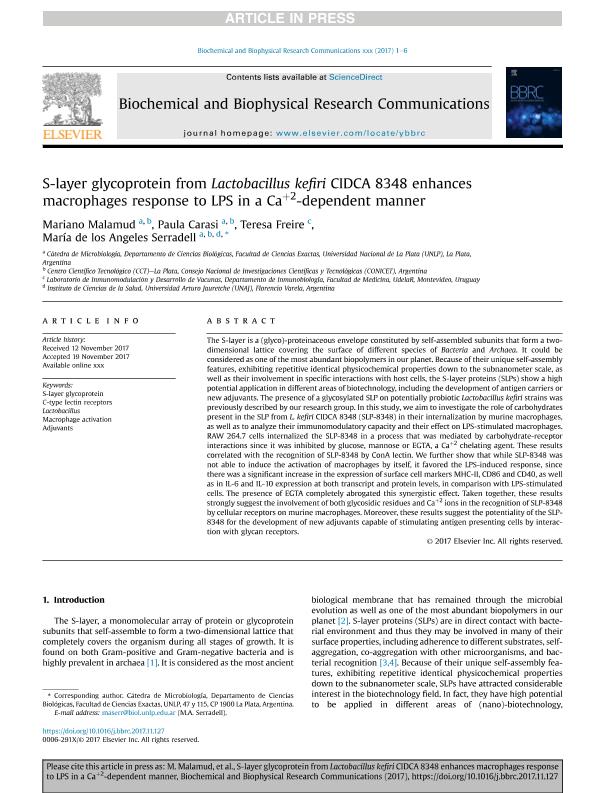Mostrar el registro sencillo del ítem
dc.contributor.author
Malamud, Mariano

dc.contributor.author
Carasi, Paula

dc.contributor.author
Freire, Teresa
dc.contributor.author
Serradell, María de los Ángeles

dc.date.available
2018-06-22T22:48:01Z
dc.date.issued
2018-01
dc.identifier.citation
Malamud, Mariano; Carasi, Paula; Freire, Teresa; Serradell, María de los Ángeles; S-layer glycoprotein from Lactobacillus kefiri CIDCA 8348 enhances macrophages response to LPS in a Ca+2-dependent manner; Academic Press Inc Elsevier Science; Biochemical and Biophysical Research Communications; 495; 1; 1-2018; 1227-1232
dc.identifier.issn
0006-291X
dc.identifier.uri
http://hdl.handle.net/11336/49867
dc.description.abstract
The S-layer is a (glyco)-proteinaceous envelope constituted by self-assembled subunits that form a two-dimensional lattice covering the surface of different species of Bacteria and Archaea. It could be considered as one of the most abundant biopolymers in our planet. Because of their unique self-assembly features, exhibiting repetitive identical physicochemical properties down to the subnanometer scale, as well as their involvement in specific interactions with host cells, the S-layer proteins (SLPs) show a high potential application in different areas of biotechnology, including the development of antigen carriers or new adjuvants. The presence of a glycosylated SLP on potentially probiotic Lactobacillus kefiri strains was previously described by our research group. In this study, we aim to investigate the role of carbohydrates present in the SLP from L. kefiri CIDCA 8348 (SLP-8348) in their internalization by murine macrophages, as well as to analyze their immunomodulatory capacity and their effect on LPS-stimulated macrophages. RAW 264.7 cells internalized the SLP-8348 in a process that was mediated by carbohydrate-receptor interactions since it was inhibited by glucose, mannose or EGTA, a Ca+2 chelating agent. These results correlated with the recognition of SLP-8348 by ConA lectin. We further show that while SLP-8348 was not able to induce the activation of macrophages by itself, it favored the LPS-induced response, since there was a significant increase in the expression of surface cell markers MHC-II, CD86 and CD40, as well as in IL-6 and IL-10 expression at both transcript and protein levels, in comparison with LPS-stimulated cells. The presence of EGTA completely abrogated this synergistic effect. Taken together, these results strongly suggest the involvement of both glycosidic residues and Ca+2 ions in the recognition of SLP-8348 by cellular receptors on murine macrophages. Moreover, these results suggest the potentiality of the SLP-8348 for the development of new adjuvants capable of stimulating antigen presenting cells by interaction with glycan receptors.
dc.format
application/pdf
dc.language.iso
eng
dc.publisher
Academic Press Inc Elsevier Science

dc.rights
info:eu-repo/semantics/openAccess
dc.rights.uri
https://creativecommons.org/licenses/by-nc-sa/2.5/ar/
dc.subject
Adjuvants
dc.subject
C-Type Lectin Receptors
dc.subject
Lactobacillus
dc.subject
Macrophage Activation
dc.subject
S-Layer Glycoprotein
dc.subject.classification
Otras Ciencias Biológicas

dc.subject.classification
Ciencias Biológicas

dc.subject.classification
CIENCIAS NATURALES Y EXACTAS

dc.subject.classification
Otras Ciencias Biológicas

dc.subject.classification
Ciencias Biológicas

dc.subject.classification
CIENCIAS NATURALES Y EXACTAS

dc.title
S-layer glycoprotein from Lactobacillus kefiri CIDCA 8348 enhances macrophages response to LPS in a Ca+2-dependent manner
dc.type
info:eu-repo/semantics/article
dc.type
info:ar-repo/semantics/artículo
dc.type
info:eu-repo/semantics/publishedVersion
dc.date.updated
2018-06-22T15:05:06Z
dc.journal.volume
495
dc.journal.number
1
dc.journal.pagination
1227-1232
dc.journal.pais
Estados Unidos

dc.description.fil
Fil: Malamud, Mariano. Consejo Nacional de Investigaciones Científicas y Técnicas. Centro Científico Tecnológico Conicet - La Plata; Argentina. Universidad Nacional de la Plata. Facultad de Ciencias Exactas. Departamento de Ciencias Biológicas. Cátedra de Microbiología General; Argentina
dc.description.fil
Fil: Carasi, Paula. Consejo Nacional de Investigaciones Científicas y Técnicas. Centro Científico Tecnológico Conicet - La Plata; Argentina. Universidad Nacional de la Plata. Facultad de Ciencias Exactas. Departamento de Ciencias Biológicas. Cátedra de Microbiología General; Argentina
dc.description.fil
Fil: Freire, Teresa. Universidad de la República; Uruguay
dc.description.fil
Fil: Serradell, María de los Ángeles. Consejo Nacional de Investigaciones Científicas y Técnicas. Centro Científico Tecnológico Conicet - La Plata; Argentina. Universidad Nacional de la Plata. Facultad de Ciencias Exactas. Departamento de Ciencias Biológicas. Cátedra de Microbiología General; Argentina. Universidad Nacional Arturo Jauretche; Argentina
dc.journal.title
Biochemical and Biophysical Research Communications

dc.relation.alternativeid
info:eu-repo/semantics/altIdentifier/doi/http://dx.doi.org/10.1016/j.bbrc.2017.11.127
dc.relation.alternativeid
info:eu-repo/semantics/altIdentifier/url/https://www.sciencedirect.com/science/article/pii/S0006291X17323069
Archivos asociados
